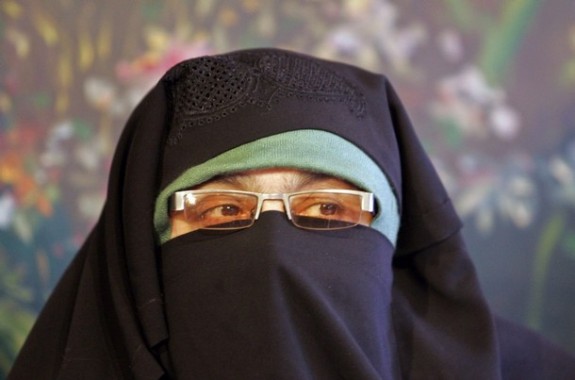
You may agree or disagree with her ideology but the founder of the first women’s organization of Kashmir, Dukhtaran-e-Millat (Daughter of the nation) Asiya Andrabi remains one of the most important women separatists in the valley. The stereotypical burka and anti-state ideology has tagged her as an Islamic extremist and separatist. While, her supporters call her the iron lady.
These definitions have been formed for her unbending anti-India stand. She has strongly stood and campaigned for bringing Islamic reform in the society. Perhaps a reason for which Andrabi has often been criticized by various sections – mainly who lean towards modernism.
Her personal life, however has been no less of a saga. Hers’ is a tale of endless trauma which has taken different shades. Sometimes, a daughter, a wife, mother and often as an individual. Here is a look at life of Asiya Andrabi -not the separatist but women.
The “iron lady” doesn’t look much of `iron” to me. A closer look at her life reveals that she is a simple woman who has struggled to fulfill her role as a mother more often than not.
For a minute, I stare at her. The middle-aged woman with tales of longing on her face sitting on a chair adjacent to mine, made me forget everything I knew about her.
The fiery daughter of the nation was a student of biochemistry. In 1981, she wanted to pursue a masters degree in Dalhousie (Himachal Pradesh) – a time when women going outside Kashmir was very rare unlike today. The turning point of her life came during this time.
Faith/ Formation of Dukhtaran-e-Millat
“I was an ambitious girl. I was shocked by this objection on my wish to study outside. But in that disappointed state Mayil Khairabadi’s book “Khawateen ki Baatein” came to my rescue,” Asiya says.
The cover story of the book is of Maryam Jameela, a christian woman who converts to Islam after studying the religion thoroughly. For Asiya, Jameela’s story was “an eye opener” to practice Islam. She did post graduation in Arabic from the University of Kashmir.
“I thought we were Muslims only by name. I began to read Quran with tafseer (meaning). I would not sleep during nights. Sometimes, I slept of on my prayer mat,” she says.
In 1982, Asiya was associated with a darsgah (Madrassa) ‘Talimul Quran’ for women which was later turned into Dukhtaran-e-Millet. She started inviting women to read, understand and practice their faith. “This was the aim of my life now. We mobilised to bring Islam in our society,”she added.
One of the campaigns of the darsgah was to demand reserved seats for ladies in local buses while other was to remove posters of nude women across the cinema halls – before the era of Militancy started in the valley.
It was only after five years of the formation of her organisation, government objected. “After the elections were held in 1987, darsgahs were locked throughout the valley. When they reached us, our women resisted. I was young and full of passion to resist,” Asiya added.
“But police raided my house and office. They told my father that I was mobilising women against India but he retorted saying that I was just trying to bring social reform,” she recalls.
It was the start of the armed-conflict in the valley. Thousands of young boys crossed over to Pakistan administered Kashmir (PaK). Syed Sallauddin of Jamaat-e-Islami an Islamic organisation initially demanded freedom but later he became one among the first to participate in the elections. “Sallaudin offered me the presidential post of their women outfit. But I rejected. I knew, election meant turning to government and there our Islamic status would vanish,” she says adding that her stand was that ‘women not be a part of the militancy’. “We would help only to bring Islam in our society.”
Marriage / Caste System
Born to a family of Syeds, a lineage that has its roots attached with the saints of valley. Andrabi placed a number of demands before her parents for marriage. One of her demand was to marry out of the Syed clan.
In Kashmir, people follow a tradition of inter-caste marriages especially those who are associated with the names of sufi saints in the valley. “I wanted to break this barrier. Allah is closer to common people then those who claim to be saints,” she said. “I had only seen arrogance among the majority in my clan. They thought high of having this name associated with them. While some are full of wisdom, many of them tried least to understand our religion. It no where justifies caste based marriages,” she stressed.
She still stands by her views. “We demand freedom from Indian rule. But Kashmiris are slaves of their own bogus customs.
“Asiya fought for her rights like any other girl in a ‘modern’ society. My relatives objected on my veil. They said who will marry a girl without seeing her face and hair. But I resisted and stood on my belief,” she laughs. Her next demand was to marry a man who stood for freedom struggle. This is what changed her life further. She married Mohammad Qasim Faktoo in October 1990 before which her organisation had been banned.
Her elder son Mohammed was born on june 13, 1992. When Mohammed was seven months old Andrabi and her husband along with the baby were arrested at the Srinagar Airport on their return from New Delhi. This is when the family of three was separated for the first time.
In twenty three years of marriage with Faktoo, the couple lived together for less than three years and that too underground. “My brothers supported us but his presence was felt every minute,” she adds.
While she says this, she gets a call. I overhear her saying, “My only hope is Allah. The government has only given us the hope to wait for his dead body to come out of the Jail, “sighs and disconnects.
“Qasim and I were given options to surrender and become part of mainstream politics. But we cannot give up. We can’t forget our martyers. He lays in prison for his conviction,” she claims.
Mother
When arrested for the first time, Mohammed was isolated with his mother for a year in Jammu. Such was the affect on the child that his mother says he would bang the door with a stone the entire day. “That stone was his toy.” First two and a half months Asiya was interrogated every day from “dawn to dusk”.
“During the interrogation Mohammed was taken away for hours. They did not torture me physically but psychologically. While saying this her eyes moisten, “Once I was surrounded by the officials, Mohammed was left away on the ground. I saw him play with his own feces.” She was often told “bohat buri khabar hain” (there is a sad news) that her husband was dead.
Asiya recalls about days when she saw her son waving at a snake from the window of a room she was put in. “They didn’t give Mohammed any baby food during my interrogation. When asked why? They said, he was not on records.”
She says, Mohammad was only breast fed by her for months. After her release in 1994, Asiya was underground till 2004. During this time, she kept changing her locations to escape from the Indian military.
Faktoo was released on December 1999 and their second son Ahmed was born the same time while they were still hiding from the government. He was held again in the same month and remains in jail. He has been sentenced to life imprisonment.
“My children saw father only behind the bars,” Asiya narrates.
During the period, Asiya was underground, both the children with her. All three had to keep changing their names in order to hide their identity. “It had a very bad affect on them psychologically. I had to change their schools. Sometimes, out of confusion and fear, they introduced themselves with different names” she sighs and says that she began to realize that she was responsible for their misery.
“I asked myself that it was my struggle and they were just paying the price.”
Mohammed was sent to Pune for his schooling after police caught them by visiting him in school in 2002. “But my son could not bear the pain of staying away from me. I had to call him back and finally decided to come out in 2004,” Asiya adds.
After much controversy over his passport and criticism, her elder son was sent to Malaysia for further studies. Asiya says it was the decision of her family. “They told me you choose your life but let him decide for himself,” she says. He stays with his aunt there.
Struggle/ Stand
Asiya faced monthly arrest in 2007 to 2009. During the unrest of 2010, she was held for consecutive two years. “Year 2009 was the worst experience for me. The prison in Jammu was turned into a Mandir (Temple) by fellow inmates. I suffered severe lung disease due to the smoke of the incense. No medical care was provided,” she grieved.
Speaking about the Kashmir issue, she still stands firm on her views against India. “My body has resigned but we have full faith in Allah. How can we turn back after giving so many lives,” she broke down. “I can’t forget the faces of our shaheeds (Matyrs).”
When I ask her about the decline in militancy and conflict, she replies “Our struggle has not ended. They can kill us but not our aspirations. We would not want to derail but instead die,” Asiya firmly puts forth and it is perhaps the first time I see the “iron lady”.
Rahiba R Parveen









Your Comment:we are happy that such a good nd honorable people are still alive
mam we need some help from you ?will you